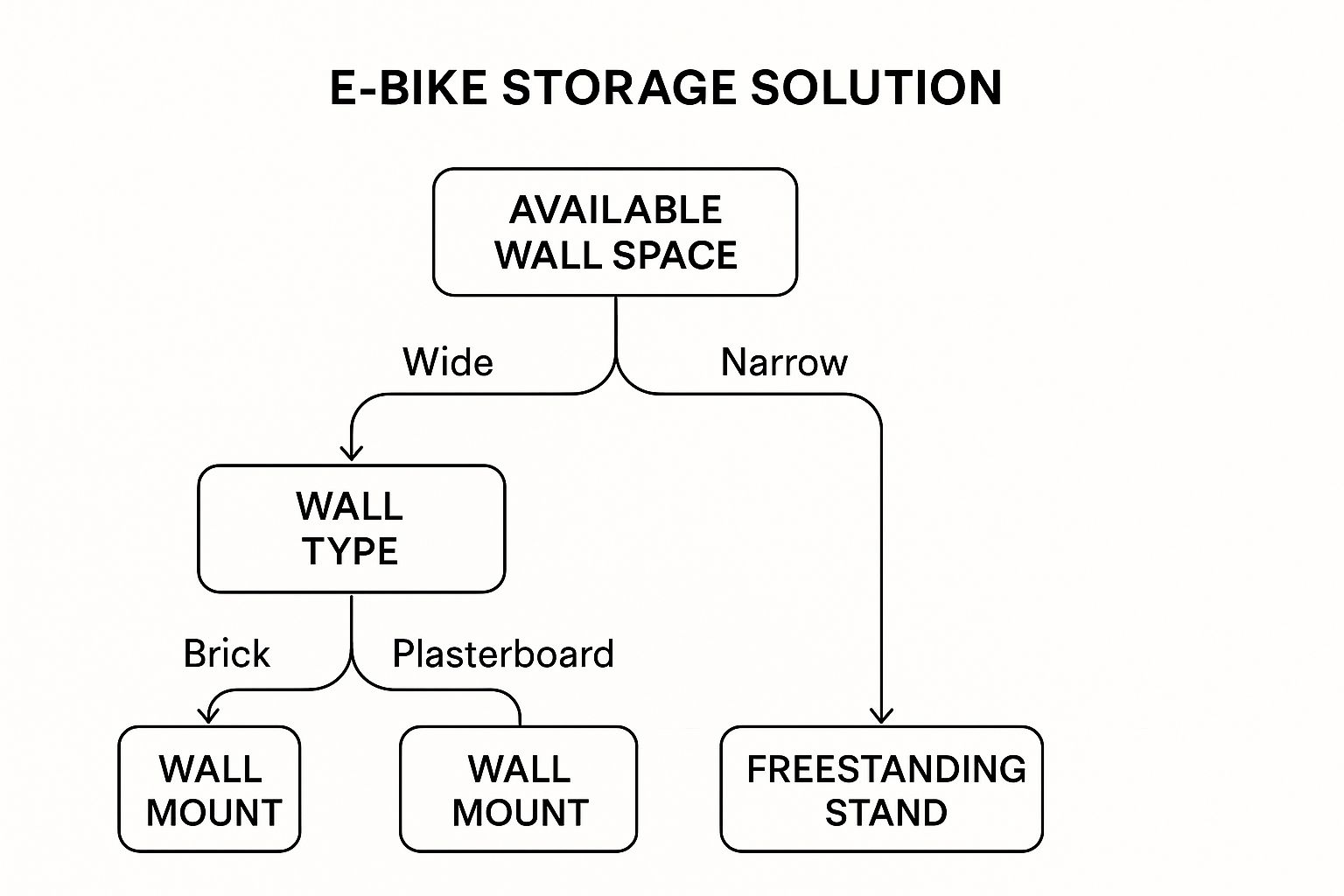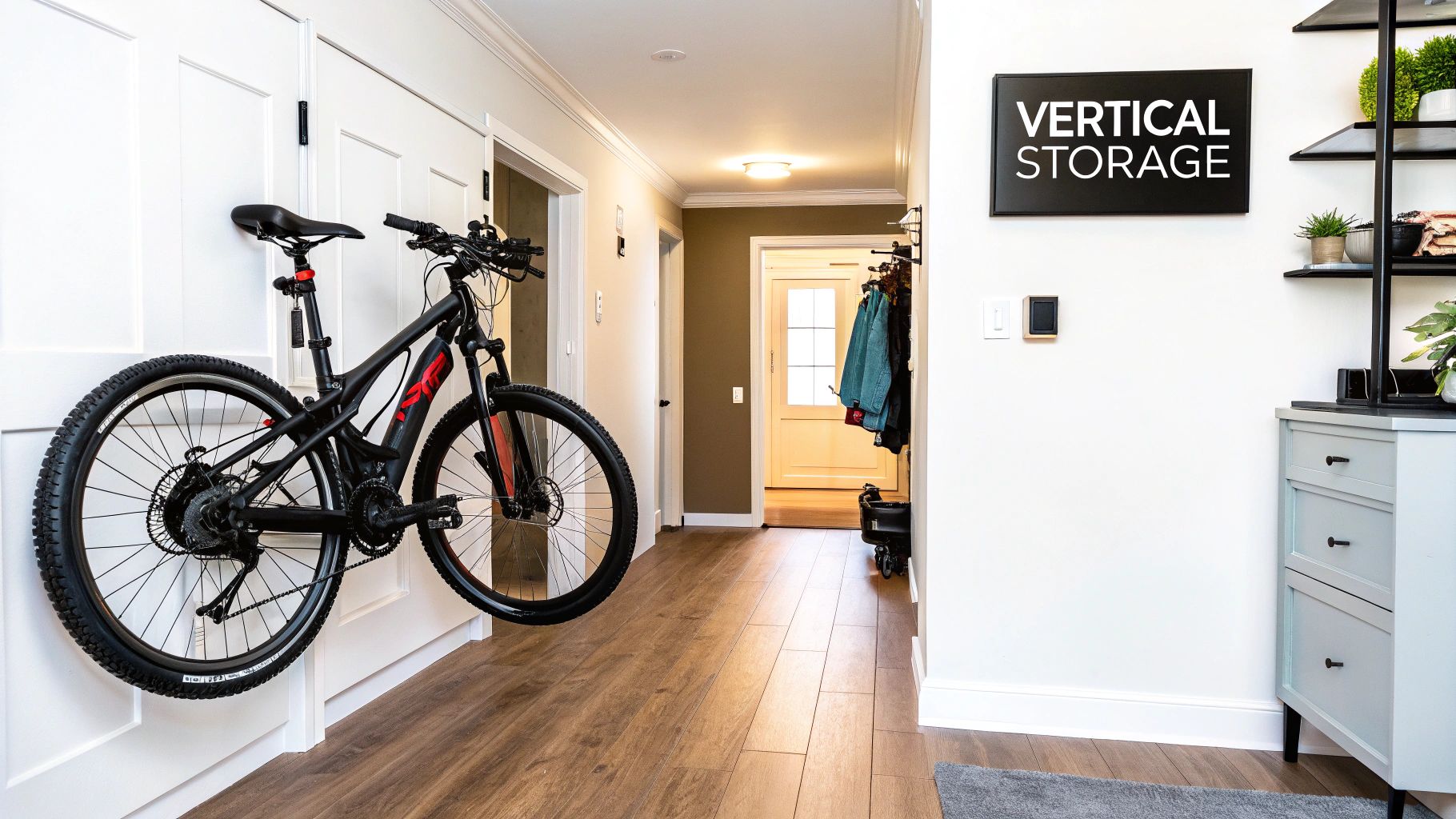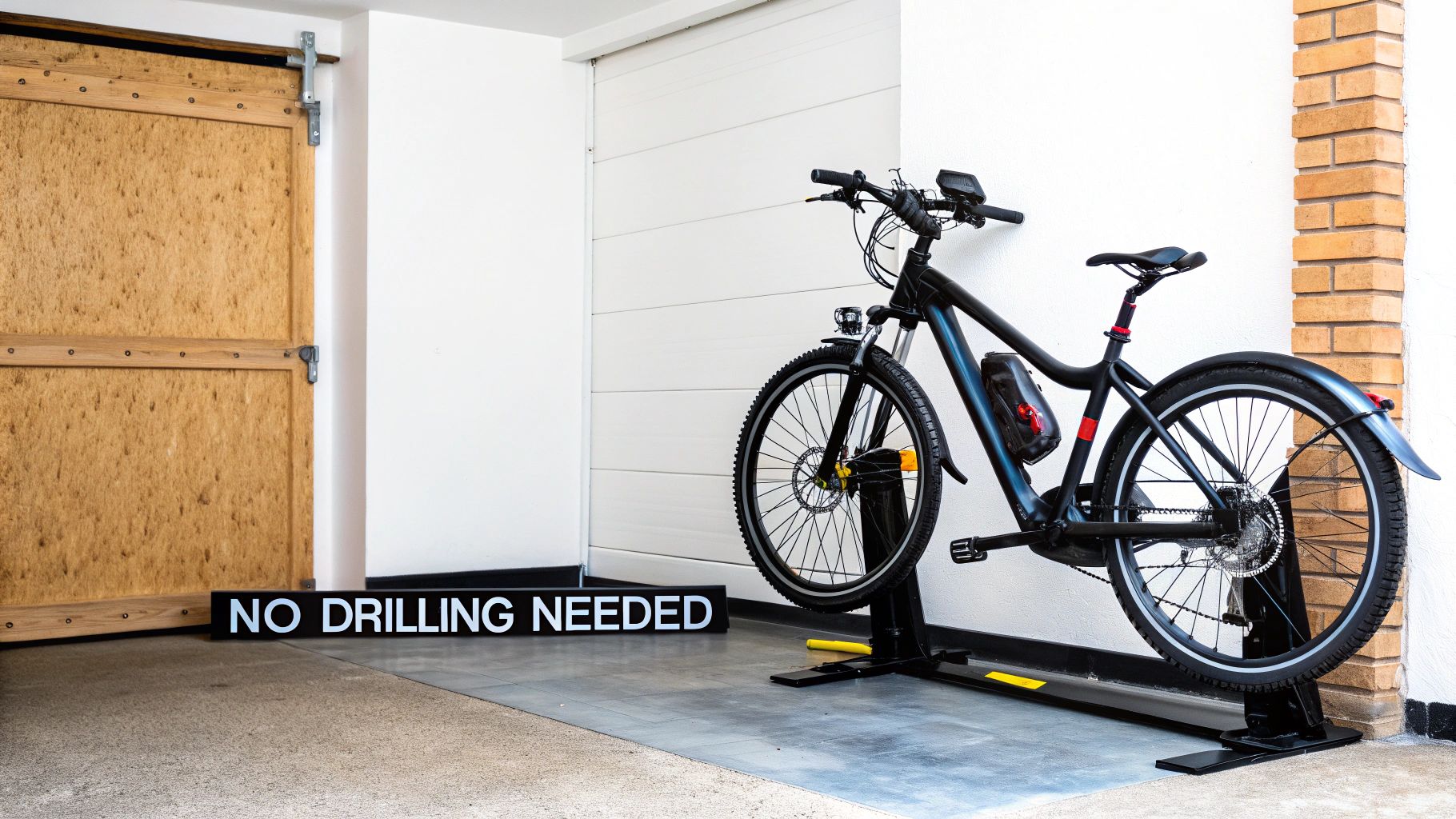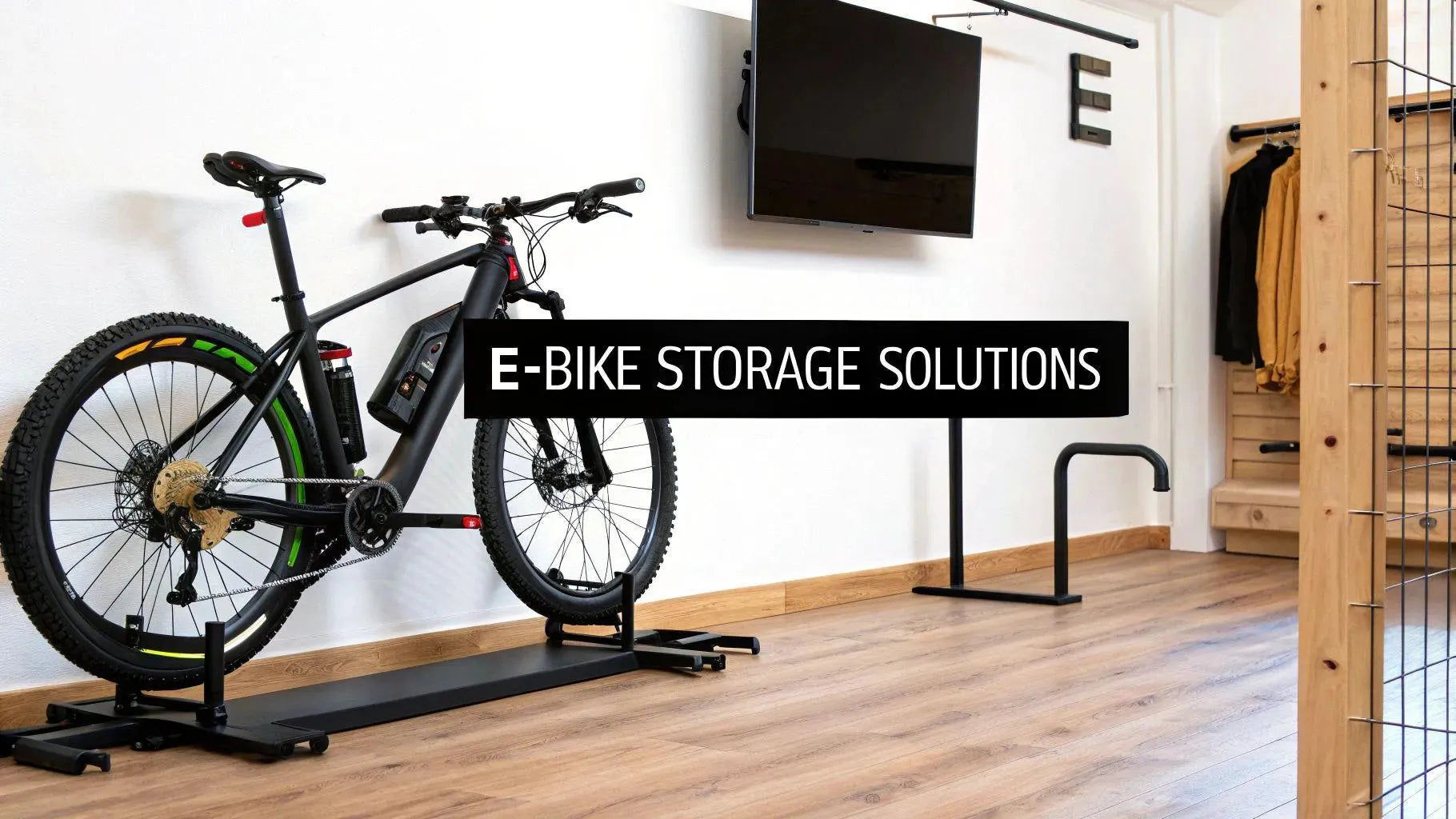Figuring out the right electric bike storage solutions is more than just getting it off the floor—it's about protecting a serious investment. Your e-bike isn't just a toy; it's a valuable piece of kit, and leaving it out in the open or exposed to the weather is a risk you just don't want to take. The right storage setup keeps it safe, easy to grab, and ready for your next ride.
Why Your E-Bike Needs a Proper Home
Let's be real: your electric bike isn't just a regular bike with a motor slapped on. It's heavier, way more valuable, and full of sensitive electronics that need a bit of looking after. For anyone living in a packed city in Australia or the US, this is a genuine headache.
Trying to lug a 25kg (about 55 lbs) e-bike up a few flights of stairs or squeeze it through a tiny apartment hallway is a workout nobody asked for. This is exactly why a smart storage plan is so crucial. It's not just about convenience; it’s about making your e-bike a seamless part of your life, not a daily struggle.
Protecting Your Investment
A good storage solution does a lot more than just clear up some space. It’s a shield against a few common headaches that can seriously devalue your bike or land you with a hefty repair bill.
- Theft Prevention: E-bikes are a hot item for thieves. Keeping your bike securely inside, or using ground anchors in a garage, is your best first move.
- Damage Control: We've all done it—accidentally knocking into things in a cluttered hallway or shared garage. A dedicated spot keeps your bike safely out of the way of those inevitable bumps and scrapes.
- Weather Shielding: Rain, humidity, and wild temperature swings can be a nightmare for your bike’s electronics and battery. Getting it stored properly indoors is key to its longevity.
More Than Just a Bike
The demand for clever e-bike storage is blowing up right alongside the e-bike market itself. The global market hit a value of around USD 61.89 billion in 2024 and is expected to rocket to USD 113.64 billion by 2030. That explosion in popularity tells you just how many people are scratching their heads over the exact same storage problems.
A dedicated storage spot transforms your e-bike from a cumbersome object into an accessible tool for daily transport. If it’s easy to put away and grab, you’re far more likely to use it every day.
At the end of the day, looking after your e-bike means giving it a proper home. That also means thinking about how to care for its most vital part. If you want more tips on that, you might want to check out our guide on how to maximize your electric bike battery life. A well-stored bike with a healthy battery is a bike that's always ready for an adventure.
Matching the Right Storage to Your Space
Before you jump online and buy the first rack that catches your eye, let's pump the brakes. The secret to great e-bike storage isn't just about the rack; it's about how it fits your bike, your home, and your lifestyle. Nailing this decision upfront will save you a ton of headaches later.
First things first, get to know your bike's vital statistics. Grab a tape measure and jot down its length, height (to the top of the handlebars), and width. Then, find its exact weight—this is a big one. Most e-bikes tip the scales between 23-36 kg (50-80 lbs), which is often way more than a standard bike hook is built to handle.
Now, turn your attention to where you plan to put it. Are you thinking of that skinny bit of wall in the hallway, or do you have a generous corner in the garage? Measure the available width, depth, and height. Remember, you don't just need space for the bike to sit; you need enough room to walk around it and get it in and out without a daily struggle.
Understanding Your Walls and Floors
The type of wall you're working with is a massive deal-breaker. If you've got solid brick or concrete, you're in luck—it can take the weight of a heavy e-bike with the right fixings. But for drywall or plasterboard walls, which are super common in US and Australian homes, you absolutely have to drill into a wooden stud. You can try tapping the wall to find a solid spot, but a cheap stud finder takes all the guesswork out of it.
Never, ever mount a heavy e-bike rack directly into drywall on its own. It’s just not strong enough. The weight will eventually rip the fixings right out, and you’ll be left with a damaged bike and a hole in your wall.
If you're renting or just don't fancy drilling, freestanding stands are your best friend. These brilliant drill-free options range from simple floor stands that hold a wheel to clever gravity stands that lean against the wall, using the bike's weight to stay put.
This simple infographic can help you see which direction to go based on your living situation.

Ultimately, what your wall is made of is just as crucial as the physical space you have.
Vertical vs. Horizontal vs. Freestanding
Armed with your measurements and a solid understanding of your walls, you can now pick a style that works for you.
- Vertical Mounts: These are absolute space-savers. They hang the bike by one of its wheels, keeping it flush against the wall. Perfect for tight hallways or tucking it away behind a door.
- Horizontal Racks: Got a bit more wall width to play with? These racks hold your bike parallel to the wall, almost like a piece of art. They're often easier to use since you don't have to lift your heavy e-bike as high.
- Freestanding Stands: The ultimate in flexibility. No drilling, no commitment. They’re a fantastic choice for renters or anyone who might want to move things around later. They do take up floor space, but they’re incredibly stable.
Finding the perfect solution can feel overwhelming, but this table breaks it down to help you see what might work best for your home.
Choosing Your E-Bike Storage Solution
| Storage Type | Ideal For | Space Impact | Effort Level |
|---|---|---|---|
| Vertical Wall Mount | Small apartments, narrow hallways, garages | Minimal floor space, uses vertical height | High (requires lifting the bike) |
| Horizontal Wall Rack | Garages, living rooms with spare wall space | Medium, keeps bike off the floor | Medium (less lifting than vertical) |
| Freestanding Stand | Renters, anyone avoiding drilling, sheds | High floor space impact | Low (easy to park the bike) |
| Ceiling Hoist | Garages with high ceilings, workshops | Zero floor space impact | Medium (involves a pulley system) |
Hopefully, that gives you a clearer picture. The right choice is the one that makes your life easier, not harder.
The demand for smart storage is booming right alongside the popularity of e-bikes. The global bike storage rack market was valued at USD 604 million back in 2025 and is only getting bigger, driven by people in cities embracing cycling. You can read more about the bike storage market growth on archivemarketresearch.com. For us, that growth is great news—it means more innovative options are hitting the market all the time, making it easier than ever to find that perfect fit.
Using Wall Mounts to Reclaim Your Floor Space

When floor space is tight, going vertical isn't just a clever trick—it's a total game-changer. Wall mounts are easily one of the best electric bike storage solutions out there, especially if you're in a smaller apartment or house. They turn a patch of unused wall into a secure home for your ride.
This approach immediately gets your e-bike out of hallways and living rooms, putting an end to accidental bumps and freeing up so much valuable room. But here’s the thing: hanging a machine that can weigh 25 kg (55 lbs) or more takes more than a generic hook from the hardware store. Safety is everything here, both for your bike and your wall.
Finding a Secure Anchor Point
The absolute golden rule of wall mounting is anchoring the rack directly into a wall stud. These are the vertical wooden beams that form your wall’s skeleton, and they’re the only thing strong enough to hold a heavy e-bike without drama. Trust me, you can't rely on drywall alone to take that kind of weight.
Not sure how to find one? You've got a few options:
- Use a Stud Finder: This is the easiest and most foolproof method. A simple electronic stud finder will light up or beep when it senses the dense wood behind the drywall.
- The Old-School Tap Test: Gently knock along the wall with your knuckles. You'll hear the sound change from a hollow echo to a solid, dull thud when you hit a stud. It takes a bit of practice, but it works.
- Look for Clues: Sockets and light switches are almost always fixed to the side of a stud. From there, you can usually measure in standard increments (typically 16 inches in the US and Australia) to find the next one.
If you’re lucky enough to have solid brick or concrete walls, you’re in great shape. With the right heavy-duty wall plugs and screws, you'll have an incredibly secure anchor point. Just be sure to use a proper masonry drill bit for the job.
Choosing the Right Mount Design
Not all wall mounts are created equal, particularly when you’re dealing with the unique demands of an e-bike. The extra weight and often chunkier frames mean you really need a mount designed specifically for the task.
A common mistake I see is people choosing a mount based on looks instead of its actual weight capacity. Always, always check the manufacturer's specs. To be safe, look for a mount that can handle at least 35-40 kg (75-90 lbs). This gives you a nice buffer and accounts for any extra gear you have on the bike.
Look for models with features that make life easier, like pivoting arms. These are great because they let you swing the bike flat against the wall after it’s hung, shrinking its profile even further. Some designs also cradle the wheel in a wider, rubber-coated hook, which helps distribute the weight and protects your rim from getting scratched up. If you're looking to fully kit out your ride, you can find other great items by checking out the best electric bike accessories to complete your setup.
Getting the Height Just Right
Finally, let's talk about positioning. Before you even think about drilling, hold the mount against the wall and get a feel for how high you’ll actually need to lift your e-bike.
Here's a pro tip: take the battery off first. This can easily shave 3-5 kg (7-11 lbs) off the total weight and makes lifting so much more manageable.
Try to position the mount so you only have to lift the front wheel a few inches off the ground to hook it on. If you mount it too high, what should be a simple task turns into a daily workout, and you're far more likely to drop your bike. Get it right, and you’ll have a storage solution that's secure, space-efficient, and genuinely easy to use every single day.
Drill-Free Solutions: Floor and Gravity Stands

Let's face it, drilling into walls isn't for everyone. If you're renting, staring down a dodgy drywall, or just want a setup you can change on a whim, freestanding stands are your best friend. They're brilliantly simple electric bike storage solutions that require zero installation—just unbox it, and you're good to go.
These stands are a total lifesaver, especially for those of us in the US and Australia where rental agreements can be notoriously strict about wall modifications. They give your e-bike a stable home without leaving a single mark. And the best part? When you move, your storage solution just packs up and comes with you.
Floor Stands: The Simple Parking Spot
The most straightforward drill-free option has to be the humble floor stand. We're talking minimalist designs that hold your e-bike upright by cradling either the front or rear wheel. You literally just roll your bike into place. Done.
The big win here is that there's no lifting involved, which is a massive plus when you’re wrangling a heavy e-bike after a long ride. The one thing you can't compromise on, though, is stability. You'll want a stand with a wide, heavy base and rubber feet to keep it from sliding on slick floors. A flimsy stand and a 25 kg (55 lb) bike is just asking for trouble.
I’ve made this mistake myself: not all floor stands can handle the beefy tyres on most e-bikes. Before you click "buy," double-check that the stand’s cradle is wide enough for your tyres. So many are designed for skinny road bikes and just won't cut it.
That simple check will save you the headache of a return and make sure your bike is held securely without pinching the tyre or damaging the rim. It's a tiny detail that makes a huge difference day-to-day.
Gravity Stands: Leaning on Physics
Gravity stands are a seriously clever bit of engineering. They let you store your bike vertically without touching a drill. The whole concept is that the stand leans against a wall, using the combined weight of the stand and your bike to create a surprisingly stable system.
Most have a pair of arms with padded hooks that cradle your e-bike's top tube, holding it horizontally off the ground. The top of the stand rests against the wall while rubber feet grip the floor, locking everything in place. It’s a fantastic solution if you need to store more than one bike, as many models are built for two.
When you're shopping for one, get really picky about the contact points.
- Wall Pads: Make sure the part touching the wall is soft, non-marking rubber or foam.
- Floor Feet: Look for wide, grippy feet that will protect your floors from scuffs and stop any sliding.
- Bike Cradles: The hooks that hold your precious frame should be deeply padded to prevent paint scratches.
These freestanding options are proof you don't need to break out the power tools to create a tidy, secure home for your e-bike. They offer the ultimate convenience and peace of mind, especially for renters and anyone who likes to keep things flexible.
How to Secure Your E-Bike at Home
Finding the perfect spot for your bike is just the first step. Now for the important part: making sure it stays there. An e-bike is a serious investment, and a rock-solid security plan is a non-negotiable part of any good electric bike storage solution. It's all about building layers of defense to get some real peace of mind.
If you're in an apartment, you might be stuck with a shared hallway or a communal storage locker. That can feel a bit sketchy, but you can make it work. The golden rule is to find something solid to lock your bike to. Never, ever just lock the wheel to the frame—a thief can just pick the whole thing up and walk away. Hunt for sturdy pipes or railings. If there’s nothing, it might be worth talking to your building manager about getting a secure anchor point installed.
Bolting Down Your Security
Got a garage, shed, or even a small patio? Your security options just got a whole lot better. The single best thing you can do is install a ground or wall anchor. These are tough-as-nails steel loops you bolt directly into concrete or brick, giving you an immovable object to lock your bike onto.
When shopping for an anchor, keep an eye out for models with a high security rating. In the US, look for ART ratings, while "Sold Secure" is a key standard in Australia and the UK. Pair one of those with a high-quality D-lock or a hefty chain, and you've made a quick getaway nearly impossible. Even if a thief gets into your garage, they won't be just wheeling your bike out. The basic locking principles are the same as on the street; our guide on how to lock an electric scooter has some solid tips that apply here, too.
A huge mistake is relying on a flimsy cable lock at home. They can be snipped in seconds with a cheap pair of cutters. Your home security needs to be just as tough—if not tougher—than what you'd use out on the street.
Smart Battery Care and Storage
The battery is the heart and soul of your e-bike, not to mention its most expensive part. It needs a little extra TLC. Whenever you can, take the battery off the bike before you put it away for the night.
This habit pays off in a few big ways:
- Easier Lifting: E-bike batteries are heavy! Removing one makes the bike way lighter and much easier to hoist onto a wall mount or stand.
- Theft Deterrent: A bike without a battery is a lot less attractive to a thief. Replacing one costs a small fortune.
- Longer Lifespan: You can bring the battery inside to store and charge it in a stable, room-temperature environment. This protects it from extreme cold or heat, which can really hammer its performance over time.
Set up a dedicated charging station indoors, far away from anything flammable. A metal shelf is a great spot. Stick with the original charger that came with your bike, and always unplug it once it’s full. A simple routine like this protects your gear and makes sure you're always ready to roll.
Your E-Bike Storage Questions Answered
Even after you've measured everything twice, a few nagging questions can still hang in the air. Deciding on the best way to store your e-bike is a big deal, so let's clear up some of the common things we hear from riders. Getting these last details sorted will give you the peace of mind to build a storage space that's safe, secure, and actually easy to use.
We’ve put together some straight-to-the-point answers to help you get over those final hurdles.
Can I Hang Any Electric Bike on The Wall?
Mostly, yes. But the better question is, "Can my wall handle my e-bike?" The weight of your bike is the single most important thing to consider here.
If you've got a heavier rig, especially one pushing past 25 kg (55 lbs), you need a mount that's specifically built for that kind of load. More importantly, that heavy-duty mount needs to be screwed directly into solid wall studs or masonry. Just slapping it onto drywall is asking for a very loud, very expensive crash.
Is It Bad to Store My E-Bike Vertically by Its Wheel?
Honestly, for almost all modern bikes, hanging them by a wheel is totally fine. Rims and spokes are engineered to take on way more force than just the bike’s own weight hanging still. It's a super common and safe way to store a bike.
The only real exception is if you have hydraulic disc brakes. Very rarely, hanging the bike vertically can let tiny air bubbles in the brake line float up into the calipers, which can make your brakes feel a bit spongy. If you ever feel a difference in your brake lever after hanging your bike, you might want to switch to storing it horizontally.
Don’t overthink it. For 99% of riders, hanging an e-bike by its wheel is a non-issue. The space you save is a huge benefit, and modern bike components are built to handle it without any problems.
Should I Remove The Battery Before Storing My E-Bike?
Yes, one hundred percent. Getting into this habit is one of the smartest things you can do for your bike and your back. Popping the battery off before you lift or store your e-bike just makes everything better.
- Lifting is a Breeze: That battery weighs somewhere between 3-5 kg (7-11 lbs). Taking it off makes the bike instantly lighter and way less awkward to hoist onto a wall mount.
- Boosts Battery Health: Storing the battery inside, away from a freezing garage or a hot shed, is a massive win for its long-term health and charging capacity.
- Adds Security: An e-bike with no battery is a much less attractive prize for a would-be thief.
It’s a simple step that protects your most expensive component and makes the daily grind of storing your bike so much easier.
What Is The Best Storage Solution for Renters?
If you're renting, your best friends are storage options that don't involve a drill. Freestanding floor stands and gravity stands are perfect choices for renters in the US, Australia, or anywhere else with picky landlords.
These require zero installation and you can just pick them up and take them with you when you move. The key is to find one with a wide, sturdy base so it won't topple over. Also, look for models with rubber or padded hooks and feet to avoid scuffing the walls or floors—that way, you’ll get your security deposit back.
Ready to find the perfect ride to go with your new storage setup? Punk Ride offers a curated selection of top-tier electric bikes and scooters to match any lifestyle. Explore our collection and redefine your commute at https://www.punkride.com.





Share:
8 Essential Electric Scooter Safety Tips for 2025
What Is Urban Mobility And How It's Changing Cities